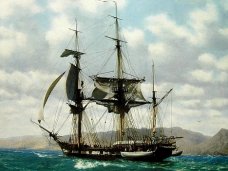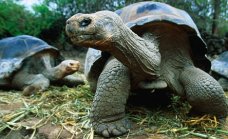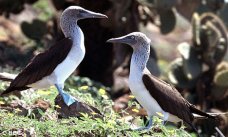 Naturalist Charles Darwin, one of the people who put the Great into Great Britain, famously sailed around the world on the Royal Navy ship HMS Beagle in the 1830s. He came up with his Theory of Evolution after visiting the Galapagos Islands, now a part of Ecuador, in 1835.
Naturalist Charles Darwin, one of the people who put the Great into Great Britain, famously sailed around the world on the Royal Navy ship HMS Beagle in the 1830s. He came up with his Theory of Evolution after visiting the Galapagos Islands, now a part of Ecuador, in 1835.
It was the behaviour of the islands' finches that helped him to discover evolution.
Now Beagle is to sail again, after the Beagle Trust said it will build a £5 million replica of the ship..
Darwin's Beagle to sail again: £5m replica will survey oceans with help from NASA craft
By Mark Prigg
11th November 2008
Daily Mail
It was the ship that carried Charles Darwin to the Galapagos Islands nearly 180 years ago, enabling him to make his breakthrough on the theory of evolution.
 Now another HMS Beagle will depart on a new voyage of scientific discovery - this time with the help of sat-nav, engines and guidance from space.
Now another HMS Beagle will depart on a new voyage of scientific discovery - this time with the help of sat-nav, engines and guidance from space.
The Beagle Trust plans to build a £5 million replica of the 19th-century vessel and use it to research the effects of plankton on the world's oceans.
Vessel of knowledge: The original HMS Beagle on which Charles Darwin sailed. A replica is being built to research the effects of plankton on the world's oceans
It will be guided to algae blooms across the globe with the help of Nasa astronauts aboard the International Space Station.
The charity has finalised its plans and is currently raising funds for its project, scheduled to begin construction within months.
'We are making a lot of progress, and I'm confident we will begin building next year, then set sail in 2010, ' said project director Peter McGrath.
 The original HMS Beagle took scientist and naturalist Darwin around the world between 1831 and 1836.
The original HMS Beagle took scientist and naturalist Darwin around the world between 1831 and 1836.
Scientist and naturalist: Charles Darwin in 1842 (aged 33)
The voyage gave him the key evidence he needed to develop his theory of evolution by natural selection.
The new vessel will be built in Milford Haven in Wales. She will be identical to Darwin's on the outside - but will contain radar, GPS, two auxiliary diesel engines and lab equipment.
'The only noticable difference from the outside will be a GPS on the mast, ' said Mr McGrath.
'However, inside it will be very modern, as obviously we need the latest scientific equipment, and to travel in comfort.'
The Beagle will initially follow the path of Darwin's expedition, crossing the North and South Atlantic, the Pacific and Indian Oceans, round both Cape Horn and the Cape of Good Hope.
It will then begin following large algae blooms, guided by astronauts. Mr McGrath said: 'We were stunned, as Nasa actually came to us and offered to help.
'They will be using their cameras and astronauts on the ISS to spot these blooms, then guiding us towards them.
'We know very little about how these massive areas of algae on the surface interact with the ocean, so we believe we will uncover a lot of firsts.'
Astronaut Michael Barratt will lead the project for Nasa. He said: 'Space stations, square riggers and marine biology: science does not get more exciting than this.'






